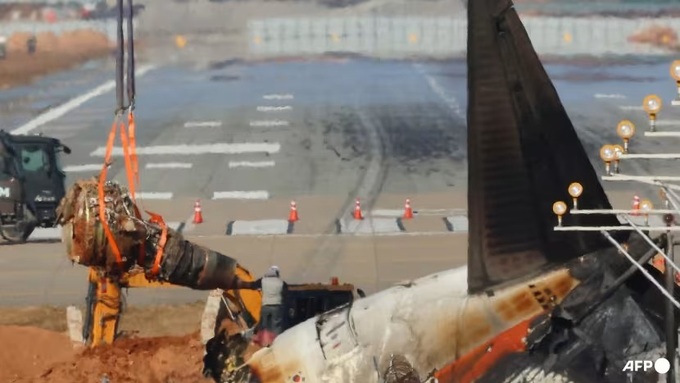
A general view shows the salvage operation of the Jeju Air Boeing 737-800 aircraft which crashed and burst into flames at Muan International Airport, in Muan on Jan 3, 2025. (Photo: YONHAP/AFP)
The flight was carrying 181 passengers and crew from Thailand to South Korea on Sunday when it issued a mayday call and belly-landed before slamming into a barrier, killing all aboard except two flight attendants.
The exact cause of the flight's crash is still unknown, but investigators have pointed to a bird strike, faulty landing gear and an installation at the end of the runway that the plane struck as possible issues.
"Today, we will lift the tail section of the plane using a crane," Na Won-ho, South Jeolla provincial police's head of investigations, told a press conference at Muan International Airport where the crash happened.
"We expect there may be remains found in that section. For all that to be complete and to have the results, we must wait until tomorrow."
Police had vowed to quickly determine the cause and responsibility for the disaster, while officers, soldiers and white-suited investigators combed the crash site.
But the transport ministry said it may take between six months and three years to determine the precise cause of the crash.
Police conducted a series of raids on Thursday and Friday of the offices of Jeju Air and the Muan airport operator as they stepped up their probe.
South Korea has also announced it will inspect all Boeing 737-800 aircraft operated by its carriers, focusing on the landing gear, which appears to have malfunctioned during the Sunday crash.
The investigation is headed by South Korean air safety officials, with the assistance of the US Federal Aviation Administration, which frequently aids with probes into global plane crashes.
Relatives of the victims have flooded to the crash site to pay their respects and collect the belongings of their loved ones.
The country's acting president Choi Sang-mok, who has been in office less than a week, said all victims were identified and more bodies had been handed over to relatives so that they could hold funerals.
